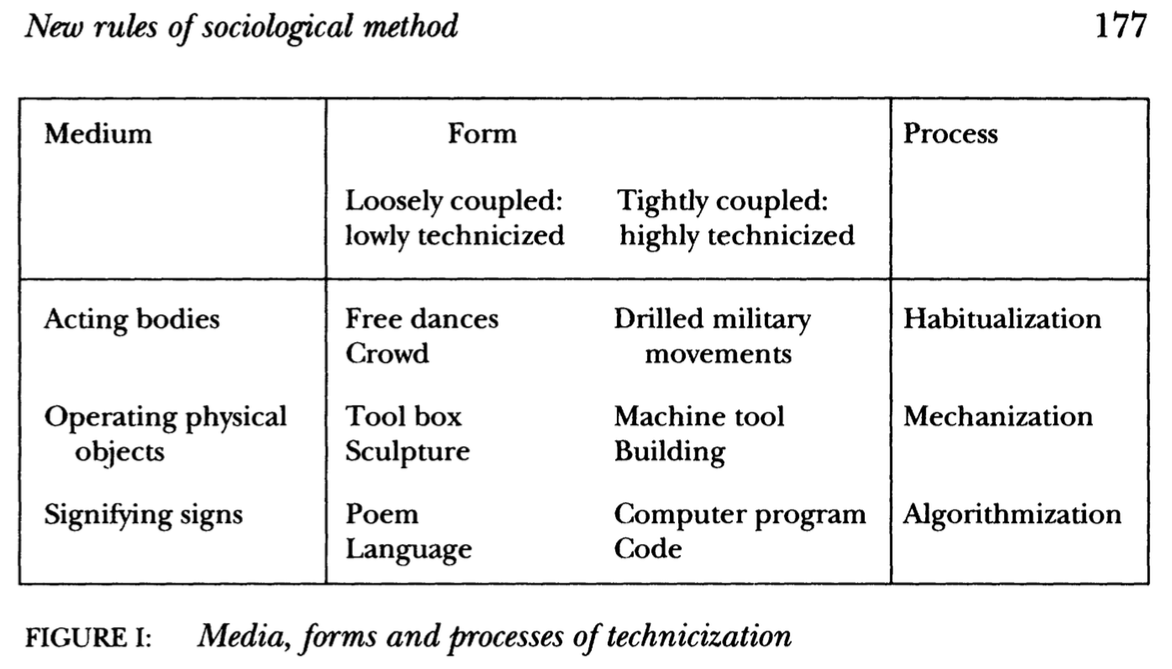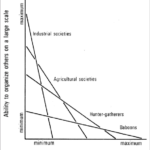
“…should…”, ou mais novas antigas regras do método (Rammert 1997)
RAMMERT, Werner. 1997. New rules of sociological method: rethinking technology studies. The British Journal of Sociology 48(2):171-91.
APELO POR COOPERAÇÃO (sociologia e estudos de tecnologia)
With this contribution I intend to increase mutual recognition and to plead for closer cooperation between general sociology and technology studies. (Rammert 1997:171)
NA TRILHA DE GIDDENS
Following his example [“Giddens’s ‘New Rules'”] I shall sketch a conceptual framework to overcome the deficiencies of both social constructivism [“adequate for the study of technology construction on the micro level, but” not “in linking it with social processes on the macro level”] and of evolutionary approaches [“adequate tool for identifying structures of selection and stabilization which shape technical change in the long run” but “have a tendency to underrate the reflexive creation of technical alternatives and the artificial and social shaping of selection environments”] in technology studies without giving up their achievements (Rammert 1997:172-3)
NOVAS 12 REGRAS DO MÉTODO
I have extracted these rules to both summarize the state-of-the-art in the field of technology studies and rethink technology studies in order to establish them as an integrated field of sociological theory and research. (Rammert 1997:173)
1. Technologies are social facts and sociological subjects in so far as they are products of previous social activity and producers of future social activity. They should be considered more generally as ‘techno-structures‘ within the stream of social action rather than single and separate material means outside of society. (Rammert 1997:173)
2. Techno-structures should be analysed as socially-constructed realities which are constituted and produced by the action of subjects […] rather than a taken-for-granted world of material objects. Techno-structures result from social actors’ structuration capacities which are based on their competence in creative action and routine formation. Techno-structures not only constrain further human action, but also enable and enforce it. (Rammert 1997:174)
3. Technology should be defined relationally as a particular social process of relating things, signs, and humans in order to cause controlled results, instead of only by its physical aspects and the ramifications thereof. It should be defined pragmatically as active construction of tools-in-use and technologies-in-contexts, not instrumentally as an ensemble of material means for specific purposes. (Rammert 1997:176)
4. Just like the techno-structures technological advancement should be deconstructed into its constituting elements and generating processes. It can be reconstructed as a continuous flow of technicization and as a contingent chain of technical developments. (Rammert 1997:178)
5. Technical development should be deconstructed into specific local technology projects where techno-structures are conceived, constructed, and negotiated. (Rammert 1997:179)
6. Technical efficiency and technological superiority should be treated as socially-constructed and open to social interpretation. (Rammert 1997:180)
7. The design variability of techno-structures completes the interpretative flexibility. We should identify the whole spectrum of projects in a technological field which propose different designs of techno-structure. Some enter the political arena of technical controversies and technology debates, and some remain in the field of academic or professional discourse. (Rammert 1997:180-1)
8. Technological artifacts are only successful in the framework of a techno-structure. The successful formation of a techno-structure should be reconstructed as a temporary result of the micro-politics of negotiation between local actors and the macro-social networking between collective actors representing the different institutional fields of society. The social closure of a controversy is but one mechanism of stabilization. (Rammert 1997:181)
9. The development of a techno-structure should be viewed as a recoursive process; it does not follow a linear and sequential pattern of evolution from the generation of an idea to the diffusion of an innovation. Technology projects always change when they enter a new institutional field. These changes should be analysed in terms of translations between different rule systems and in terms of coordinations in conflict arenas and in networks constituted by actors from different institutional fields. (Rammert 1997:182)
10. The formation of techno-structures and the association of actor-networks can be subjected to a strategical analysis on a local level and with a short-term perspective; but in the long run and on the global level the structuration process should be treated as ‘blind variation‘ because of its blindness to long term effects and of its unintended consequences. (Rammert 1997:183-4)
11. If continuities and discontinuities of technical development cannot be sufficiently explained by either the aggregation of decisions, or the connection of situations on the local level, then the global dynamics of technical development should be reconstructed with a sociocultural concept of evolution which allows for analysis of institutionalized mechanisms of productive variation, structural selection, and reproductive stabilization. (Rammert 1997:184)
12. Technical change neither results from a structural logic of development that operates beyond the scope of social actors, as Durkheim’s first rule may suggest, nor is it entirely open to voluntary action and various construction of technology, as social constructivism may suggest. (Rammert 1997:186)
TECNICIZAÇÃO
The technicization of action and perception means the social process of establishing effective schemata as tools of practice with an end-in-view […]. Techno-structuration takes place when the heterogeneous elements of these technicization processes are coupled and transformed into artificial and relatively closed systems in a manner which allows the intended effects to be expected with high reliability. Actual technical systems, like an atomic power plant, can be composed out of acting bodies following skilled routines of behaviour, operating machines causing calculated effects, and signifying symbols aligned by programmes. We usually speak of a functioning technology when the heterogeneous elements are closely coupled and interact according to the rules. Nevertheless, the remaining contingency and the complexity of techno-structures may cause breakdowns and accidents at any time. They remind us of the ‘unruly’ and risky aspects of technology […]. (Rammert 1997:176)
With the concept of techno-structuration I have suggested new research questions arise. Technology studies may investigate the degree of technicization. As concerns coupling and programming, from which degree on are action routines, physical objects, or sign systems used and acknowledged as technology? When does education change into training, when does art turn into technology, when does play become technique? Technology studies may analyse the modes of coupling between different parts and kinds of the technical system. Which type of coupling assures stability or flexibility and what are the implications under the aspects of rationality and risk […]? Technology studies may also be concerned with defining the degree of ‘hardness’ or ‘reversability’ of techno-structures. What is the scale of a technical system? What is the role of the material parts? What can we say about the reproduction of the techno-structure by people’s practices, e.g. how far do the individual mobility habits strengthen the automobile traffic system? (Rammert 1997:177-8)
Technicization – meaning the transformation of a practice into a technology as a part of a techno-structure – is a fundamental social process. The paradox of technicization consists of the fact that it is basically contingent like all social processes, but that it is also its particular function to relieve social life from the whims of contingency by establishing techno-structures and delegating social action to technological artifacts. Thus, technicization is a method to reduce the uncertainty and ambiguity of social life. But if a technology does not function any longer as intended or breaks down completely, its social constructedness becomes apparent. Trust in technology’s undoubted functioning is then broken […]. The technological artifact is no longer taken for granted as a ‘natural’ part of everyday routine. It becomes a risk and a laboratory for experimenting with new techno-structures […], or ends up as an exhibit in a technical museum or as junk in the scrap-yard. (Rammert 1997:178)

TECNOESTRUTURAÇÃO
This concept of techno-structuration connects technology studies more intensely with sociology than other approaches do. Although it draws from social constructivism, the actor-network approach and evolutionary economics, it differs from them. Its subject are the social process of technicization and the particular social relations constituting a techno-structure, and not the individual technical artifact, such as the bicycle, the fluorescent lamp or bakelite […]. The concept of techno-structuration follows the actor-network approach insofar as it calls for an integration of natural and artificial objects into the sociological concepts of action, social system and social structure. However, it differs from some exaggerations of this approach because it distinguishes between reflexive human agents and nonreflexive nonhuman agents with respect to the ability to construct networks or technological systems. (Rammert 1997:187)





 LaSPA is located at the Institute of Philosophy and Human Sciences (
LaSPA is located at the Institute of Philosophy and Human Sciences (